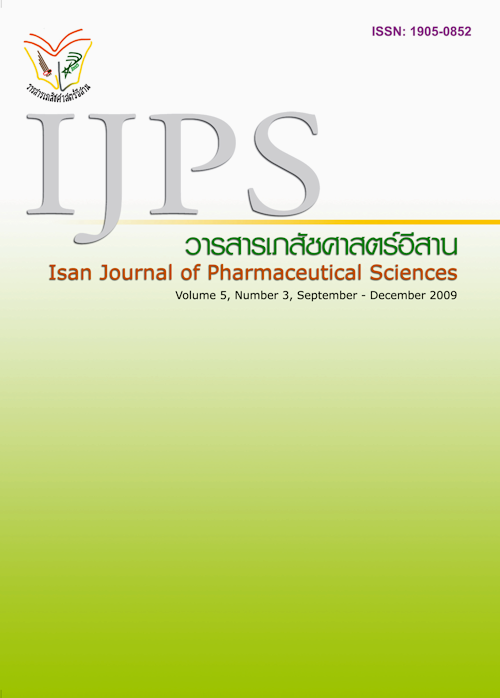Study on Cytotoxicity and Genotoxicity of Repeatedly Fried Cooking Oils by Cell Culture
Main Article Content
Abstract
This study aimed to investigate the formation of polycyclic aromatic hydrocarbons (PAHs) and cytotoxicity of extracts from repeatedly fried cooking oils. Special focus was on the correlation between the level of total polar compounds (TPCs) and toxicity to the hepatoma cell line (HepG2). Soybean (SBO) and palm (PO) oil samples were prepared by frying dough at high temperature (165°C), and periodically determining %TPCs by the standard IUPAC 2.507 method. Analysis of PAHs was carried out by liquid extraction followed by gas chromatography (GC), using PAHs mixed consisting of 18 PAHs compounds as standards. Cytotoxicities were measured using cell viability (MTT assay) and micronucleus assays. Results showed undetectable levels of PAHs in frying SBO at %TPCs less than 25%. By comparing fluorene, phenanthrene and anthracene were detected in PO at 20.30% and higher, indicating the formation of PAHs in PO when its %TPCs were close to or exceeding the legal limitation of 25%. Cytotoxicity of extracts from repeated frying PO was confirmed by the reduction of cell viability at 48 and 72 hours incubation. Formation of micronucleus gradually increased with increases in %TPCs, and reached significant levels at 39.66%TPCs and 29.54%TPCs for SBO and PO, respectively. Results from this study suggest that carcinogenic PAHs form when cooking oils are repeatedly used. This is the case for higher %TPCs especially. These findings may aid campaigns for consumer protection against toxic substances generated from repeatedly used cooking oil.
Article Details
In the case that some parts are used by others The author must Confirm that obtaining permission to use some of the original authors. And must attach evidence That the permission has been included
References
Conserving oil quality [online]. 2005. [cited 2009Feb 24]. Available from http://www.asiafoodjournal.com
Dobarganes MC, Velasco J, Dieffenbacher A. Determination of polarcompounds, polymerizeds and oxidized diacylglycerols and triacylglycerols in oils and fats. Pure Appl Chem 2000; 72: 1563-1575.
Halliwell B, Gutteridge JMC. Can oxidation DNA damage be used as abiomarker of cancer riskin humans problems, resolution studies. Free Radical Research 1998; 29: 469-486.
Hodgeson JW. Polycyclic aromatic hydrocarbons: EPA method 550.1. US Environmental Protection Agency 1990; 143.
Howard JW, Fazio T, White RH. Polycyclic aromatic hydrocarbon in solvent use in extraxct edibleoils. J Agr Food Chem 1994; 2: 5-7.
Manoj K, Padey A, ditya B, Pant MD. In vitrocytotoxicity of polycyclicaromatic hydrocarbonresiduesarising through repeated fish fried oil in human hepatoma Hep G2 cell line. Toxicology in Vitro 2006; 20: 308-316.
Ramesh M, et al. Bioaviability and risk assessment of orally ingested polycyclic aromatic hydrocarbon. J Toxicol 2004; 23: 301-333.
Valentin-Severin I, Le Hegarat L, Lhuguenot JC, Le BonAM, Chagnon MC. Use of HepG2 cell line for direct or indirect mutagens screening: comparative investigation between comet and micronucleus assays. Mutation Research2003; 536: 79-90.


